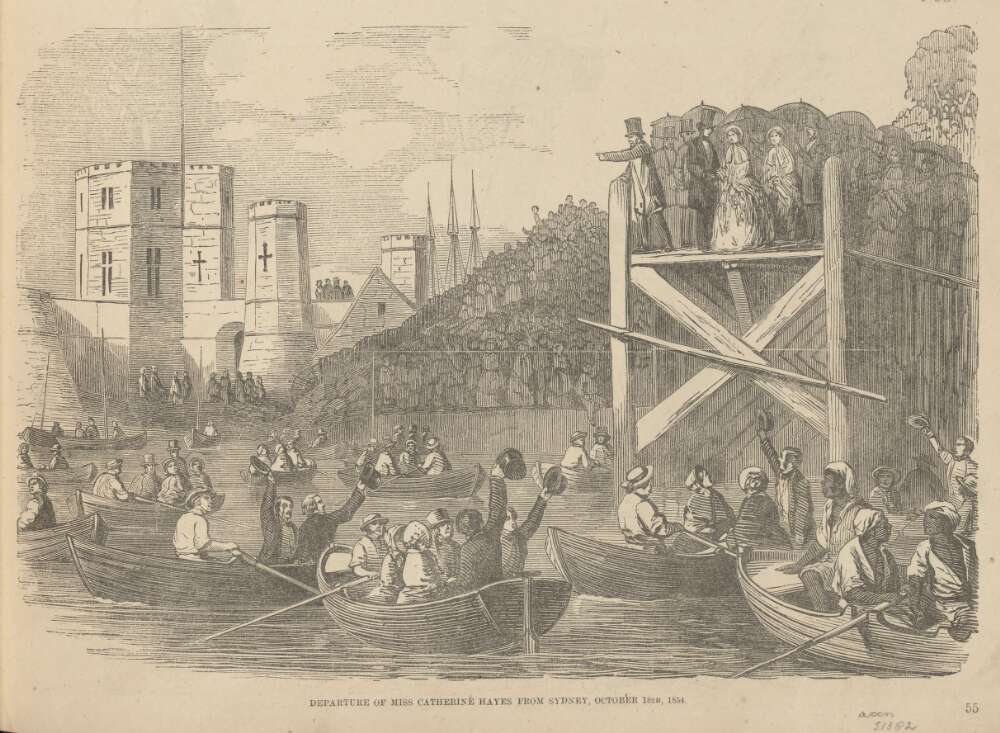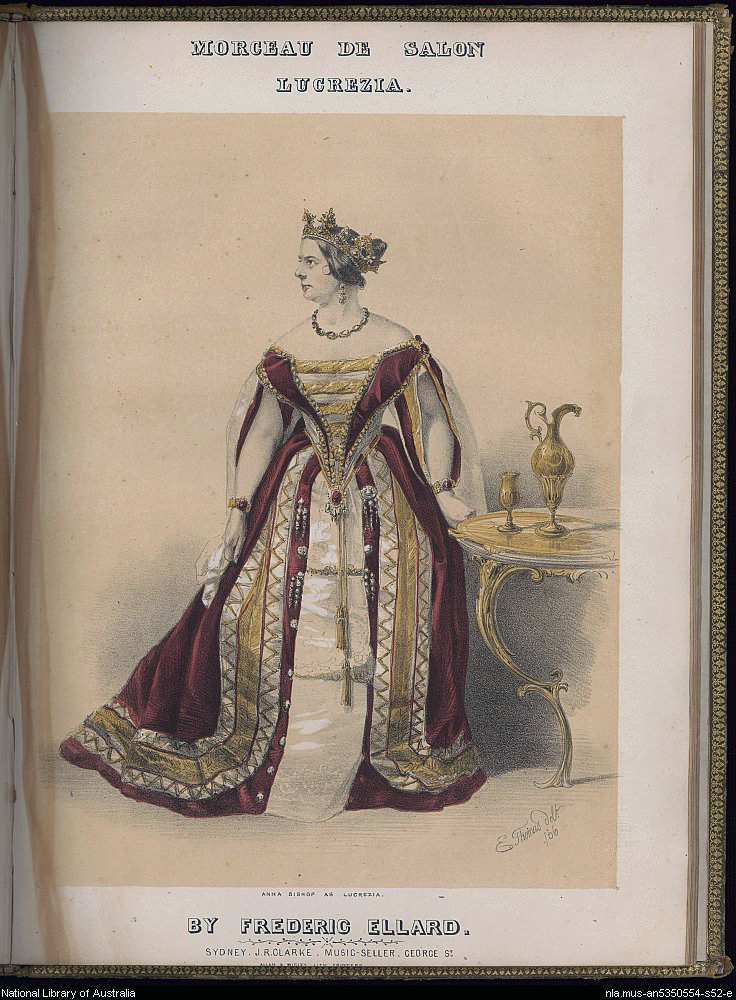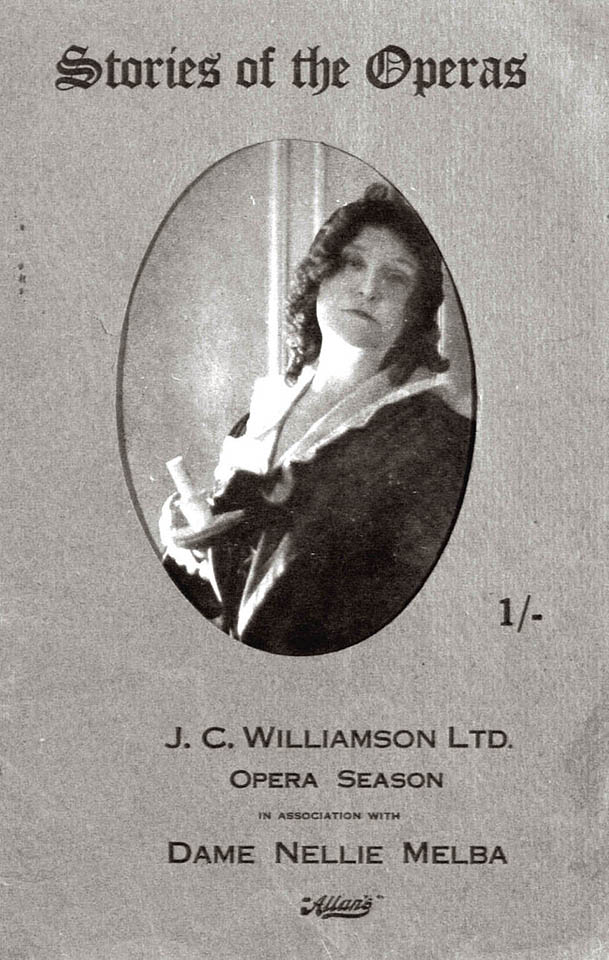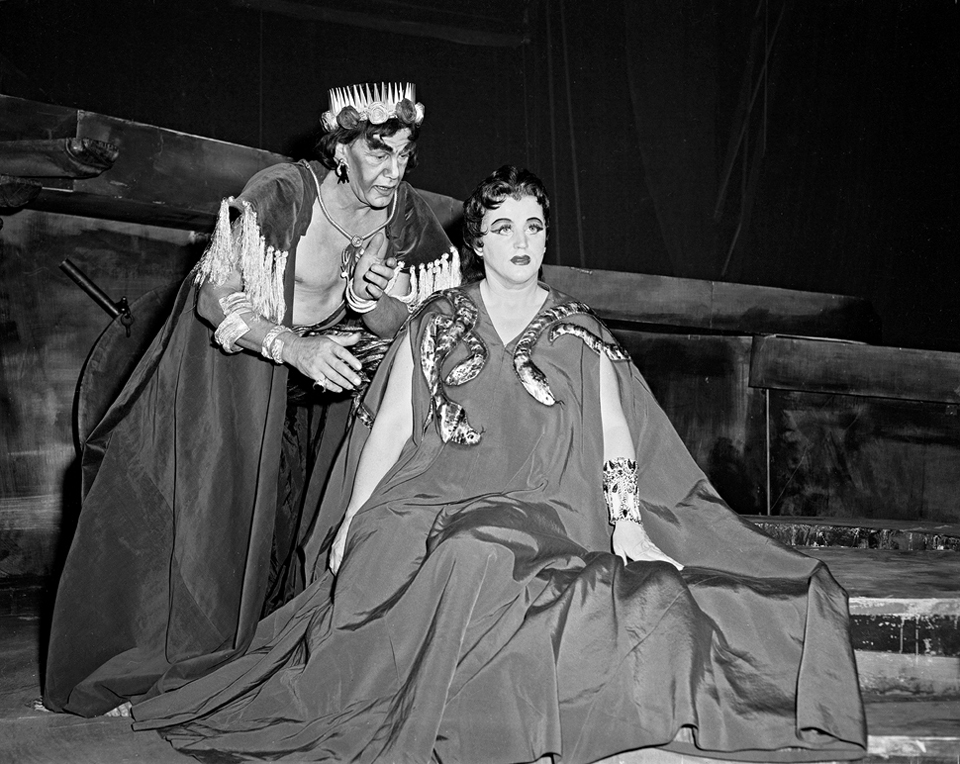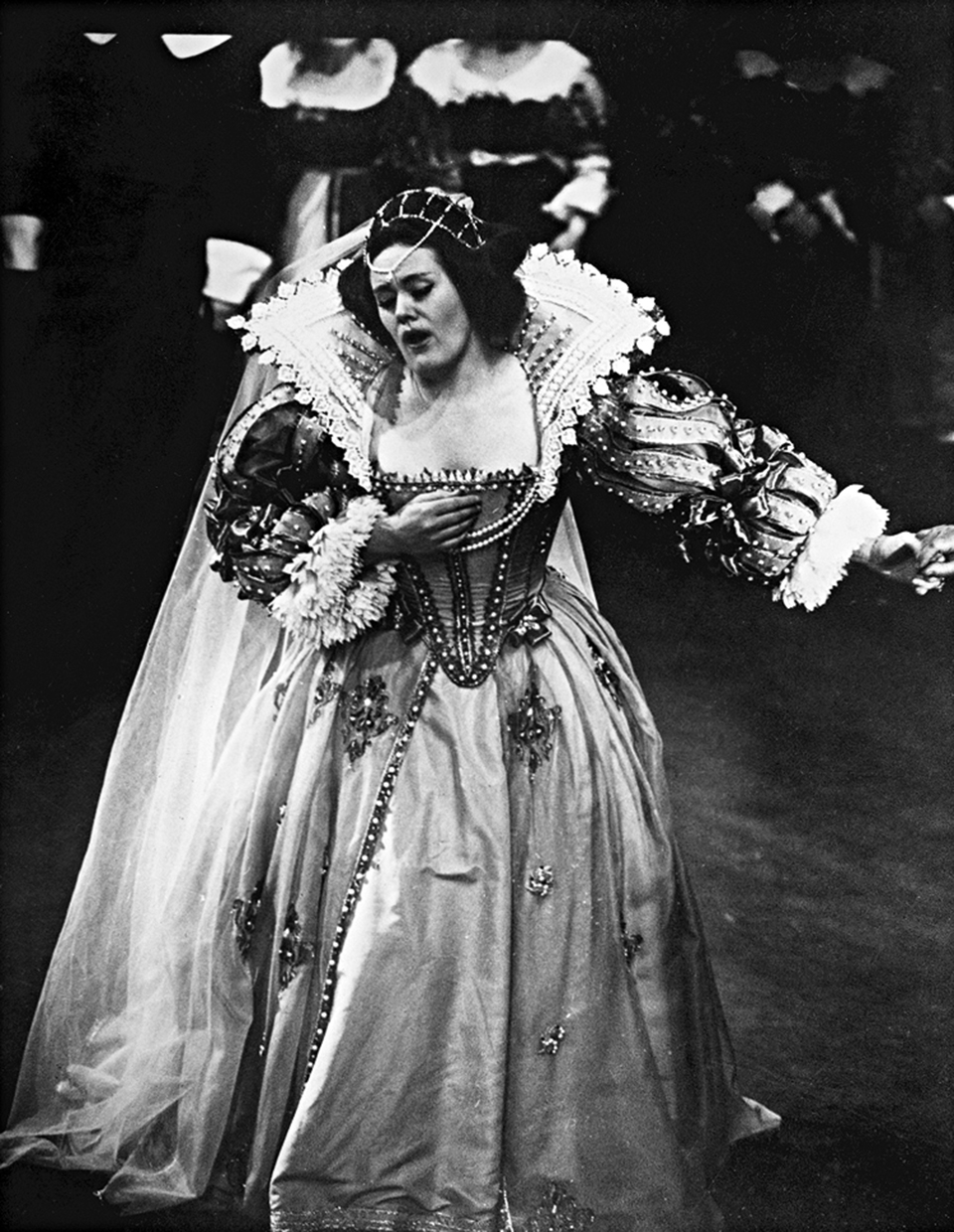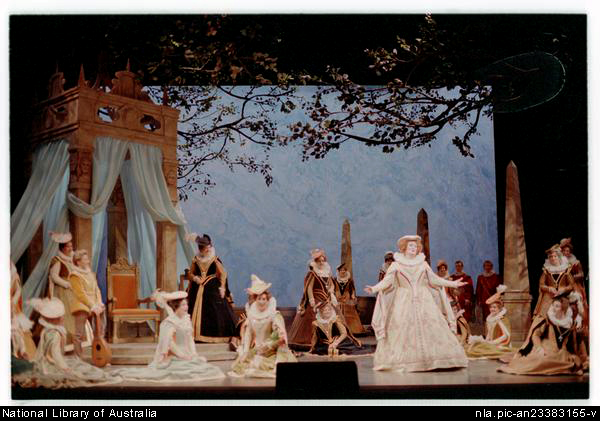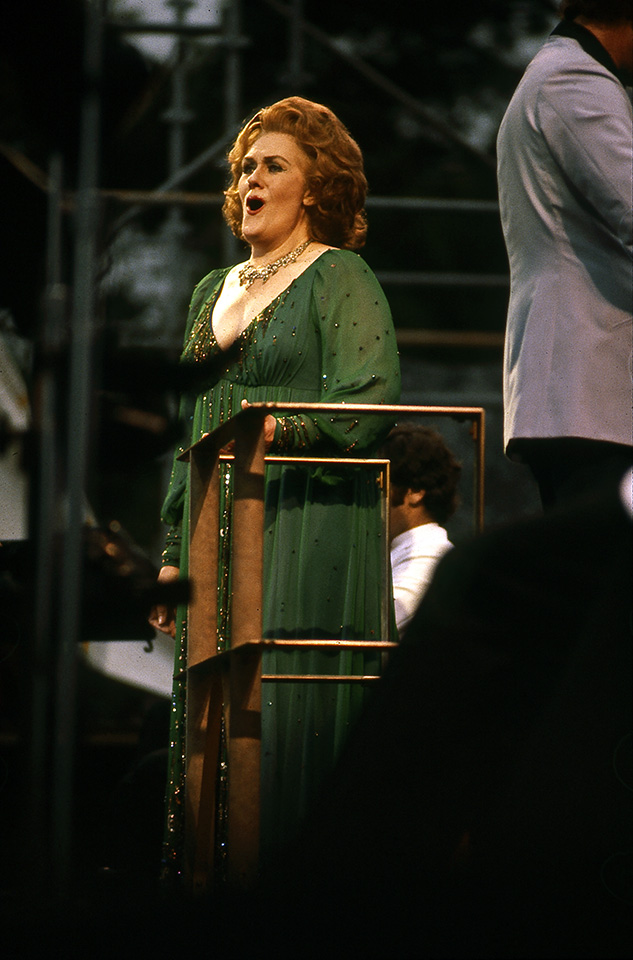The Dictionary of Sydney was archived in 2021.
Opera
Citation
Persistent URL for this entry
To cite this entry in text
To cite this entry in a Wikipedia footnote citation
To cite this entry as a Wikipedia External link
Opera
Opera is regarded as an entertainment for the elite, but in Australia it was pioneered by convicts. In 1796 Robert Sidaway, a housebreaker who had been transported for life and had become a baker after being pardoned, opened a theatre in The Rocks at the southern end of Windmill Row (now underneath the approach to the Harbour Bridge). [1] [media]On 16 July 1796 he staged the first opera known to be performed in Sydney, The Poor Soldier by William Shield. [2]
In the 1820s several ballad operas were performed by convicts at the Emu Plains prison farm, but the theatre was closed by Governor Darling in 1830. [3]
The first wave: house companies and English opera
The first regular performances came with the building of Barnett Levey's Theatre Royal in 1832 behind the saloon of the Royal Hotel, on the eastern side of George Street between Market and King streets (near today's Dymock's Building). Presenting plays, operas and 'extravanganzas', Levey's company was the first of the 'house companies' that dominated opera performance in Australia until the 1860s. The Royal closed after Levey's death in 1837, but soon Joseph Wyatt opened the Royal Victoria Theatre, on the western side of Pitt Street between Market and King streets (where the Mid City Centre is today).
The works performed [media]at these theatres were mostly English 'ballad operas' such as Bishop's Clari and Balfe's The Bohemian Girl. Italian operas (sung in English) became popular in the 1840s. The Royal Victoria saw performances of Rossini's The Barber of Seville, Bellini's La Sonnambula and Mozart's The Marriage of Figaro. Australian works were also performed, such as Edward Geoghegan's The Currency Lass and Isaac Nathan's Don John of Austria, which received six performances in May 1847. [4]
Opera was not regarded as a unique, 'higher' form of entertainment. It shared the evening's bill with plays, musical comedies, 'burlesques' (satires of existing operas) and novelty acts. All classes went to the theatre – the well-to-do sat in the stalls and dress circle, the working class in the cheap seats in the gallery and pit. [5] As most theatres were built in or adjacent to hotels, audiences were well-supplied with liquor, and prostitutes openly solicited customers in the auditorium well into the 1870s. [6]
The second wave: touring companies and Italian opera
The 1850s saw more performances of Italian operas in the original language due in no small part to successful tours by Catherine Hayes and Anna Bishop. [7] These tours also marked the beginning of the format that was to dominate Sydney opera for the next century – opera presented by touring companies.
Catherine Hayes, the 'Swan of Erin', [8] was the first prima donna of truly international reputation to visit Australia. During her 1854 concert tour Sydney was seized by 'Hayesmania' – the theatre was mobbed when tickets went on sale [9] and on her departure [media]a crowd escorted Hayes from Macquarie Place to Circular Quay. [10]
[media]The English soprano Anna Bishop achieved notoriety when in 1839 she left her husband, the composer Henry Bishop, for Nicholas-Charles Bochsa, a composer and musician wanted for forgery in France. In Sydney in 1855–56 Bishop sang concerts, operas and a burlesque called Anna Bishop in Australia, in which she appeared as six different prima donnas singing in six languages. [11] Bochsa conducted Bishop's appearances until ill health forced him to withdraw. He died on 6 January 1856 and was buried in St Stephen's cemetery, Newtown, where the monument erected by Bishop can still be seen.
The most prominent of the many touring companies over the next decades were those of the American impresario WS Lyster, and the Melba–JC Williamson Grand Opera companies.
Lyster brought his companies to Sydney between 1861 and 1880, a period that came to be known as 'the golden age of Australian opera.' [12] Lyster's companies included Australian singers such as the contralto Lucinda Chambers (the first Australian to sing at La Scala) and the tenor Armes Beaumont, who lost his left eye in 1867 when Lyster accidentally shot him while hunting quail.
Lyster's seasons included the traditional Donizetti and Bellini, and new Verdi operas such as I Puritani (in 1863). He introduced Sydney audiences to Meyerbeer's Les Huguenots (1862) and Gounod's Faust (1864), and brought Wagner to Sydney with Lohengrin [media]in 1879.
Melba
In 1911 [media]the entrepreneur JC Williamson staged Dame Nellie Melba's first opera tour. At Her Majesty's Theatre (at the corner of Pitt and Market streets, now the site of Centrepoint) Melba performed the operas in which she had become famous – La Traviata (Verdi), La Boheme (Puccini), Faust, and Rigoletto (Verdi). Melba last appeared in Sydney on 8 August 1928, performing scenes from La Boheme and Verdi's Otello.
The star of Melba's 1928 company was the Italian coloratura soprano Toti dal Monte, but not just for her performances. On August 23 she and the tenor Enzo de Muro Lomanto married at St Mary's Cathedral. A crowd estimated at 20–25,000 surrounded the cathedral, and the radio broadcast of the service was relayed to the rest of the country. After a reception at Romano's the couple honeymooned at Toronto on Lake Macquarie.
1930s–1960s
The 1930s saw opera presented in non-traditional ways. In 1934–36 the Australian Broadcasting Commission broadcast operas live from the 2FC studios in Market Street (now the Myer building) featuring the expatriate soprano Florence Austral. In between sporadic visits by touring companies, mixed professional and amateur casts performed operas at the Sydney Town Hall, and the Sydney Conservatorium presented student performances, including Joan Sutherland's opera debut in 1951 in Judith by Eugene Goossens.
The Sydney Symphony Orchestra began presenting concert performances of works beyond the resources of the local companies, performing Strauss's Elektra and Salome at the Town Hall with Marjorie Lawrence in 1951 and Der Rosenkavalier in 1955. (The 1990s saw Edo de Waart conducting Wagner's Der Ring des Nibelungen which had not been heard in Sydney since Thomas Quinlan's production in 1913.)
The early 1950s saw seasons by two groups claiming [media]to be the 'national' opera company. Clarice Lorenz's New South Wales National Opera and Gertrude Johnson's Melbourne-based National Theatre Opera Company performed at the Tivoli Theatre (on Castlereagh Street near Central Station), the Melbourne company scoring a huge success with Menotti's The Consul with Marie Collier. But both companies soon fell victim to financial problems and politics.
Their demise led to the formation of the Elizabethan Trust Opera Company. In 1957 the company performed four Mozart operas at the Elizabethan Theatre (formerly the Majestic) in Newtown. Expatriate Australians were brought back to give polish to the company, notably Joan Hammond who sang Tosca (Puccini) in 1957 and returned in 1960 [media]to perform Salome, when the media made much of Hammond's willingness to perform the Dance of the Seven Veils herself. [13]
JC Williamson made a final foray into opera in 1965 when they presented the Joan Sutherland-Williamson Grand Opera season at the 'new' Her Majesty's, the converted Empire movie theatre in Quay Street near Railway Square (now a block of apartments). Sydneysiders got [media]to see Sutherland performing Lucia di Lammermoor and also enjoyed the talents of Luciano Pavarotti at the beginning of his career.
The third wave: a permanent company
In 1966 the Elizabethan Trust Opera Company became a permanent company. It was renamed the Australian Opera in 1970, and started performing in the Sydney Opera House in 1973. Opera in Sydney moved into its third phase – a permanent company performing in a permanent location.
Joan Sutherland and Richard Bonynge joined the Australian Opera in 1974 and developed its strengths in bel canto repertoire. Sutherland appeared regularly with the company and retired after [media]her appearance in Les Huguenots on 2 October 1990 at the Opera House.
[media]In 1982 the Australian Opera presented the first Opera in the Domain, a free performance of La Traviata starring Sutherland before a rain-soaked crowd of 20,000. [14] The event runs every January and attracts 100,000.
[media]The Australian Opera merged with the Victorian State Opera in 1996 and became Opera Australia. As the national opera company it presents a mix of traditional Italian, German and French repertoire with contemporary works. Since 2002 Opera Australia has been complemented by Pinchgut Opera, which specialises in baroque works played on early instruments.
References
Alison Gyger, Australia's Operatic Phoenix, Pellinor, Sydney, 2005
Alison Gyger, Civilising the Colonies, Pellinor, Sydney, 1999
Alison Gyger, Opera for the Antipodes, Currency Press/Pellinor, Sydney, 1990
Robert Jordan, The Convict Theatres of Early Australia 1788–1840, Currency House, Strawberry Hills NSW, 2002
Notes
[1] Robert Jordan, The Convict Theatres of Early Australia 1788–1840, Currency House, Strawberry Hills NSW, 2002, pp 68–72
[2] Robert Jordan, The Convict Theatres of Early Australia 1788–1840, Currency House, Strawberry Hills NSW, 2002, pp 50, 52
[3] Robert Jordan, The Convict Theatres of Early Australia 1788–1840, Currency House, Strawberry Hills NSW, 2002, pp 173–74
[4] Sydney Morning Herald, 3 May 1847, p 2
[5] Sydney Morning Herald, 16 September 1863, p 8
[6] Sydney Mail, 2 November 1872, p 558
[7] Deborah Crisp, '"Acted and sung in Italian": Catherine Hayes and Anna Bishop in Sydney, 1855–1856', Australasian Music Research, no 4, 1999, p 34
[8] Sydney Morning Herald, 24 August 1855, p 8
[9] Illustrated Sydney News, 30 September 1854, p 261
[10] Sydney Morning Herald, 19 October 1854, p 5
[11] Alison Gyger, Civilising the Colonies, Pellinor, Sydney, 1999, pp 83–84
[12] Alison Gyger, Civilising the Colonies, Pellinor, Sydney, 1999, p 119
[13] Sydney Morning Herald, 1 February 1960, p 7
[14] Sydney Morning Herald, 19 January 1982, p 1
.




